Description
In conserving water for agricultural use, damliners in Kenya are a good choice for water pans. They preserve the water by preventing seepage into the soil, and last for many years in use. This is why when training growers and aqua-culturists on how to harvest water using damliners in Kenya, there are many considerations
These factors affect the size of all damliners in Kenya, and the liner thickness to install in water pans. Others determine where the water reservoir is located, and consequently the damliner. Water harvesting using damliners is done for rain roof top water from houses and buildings, borehole water, rain ground run-off water, from the river or lake

A damliner in Kenya installed on large water pan by Grekkon Limited in Milalani area, Kwale county
Damliners In Kenya
How to Harvest Water Using Damliners
Factors to consider
1. Land size
The amount of water required for half an acre is less than that needed for 20 acres. The latter will harvest more water to irrigate the greater acreage, and the former will have less water harvested. The bigger the volume of water reserved, the larger the damliner size
2. Location
The amount of rain fall is different in every climatic zone. Growers in the cool wet highlands have just a few dry months in the year, while farmers in the dry zones have more dry months than wet. In regions where the interval between rains is long, larger reservoirs are built for the same acreage as that in the cool wet location. Again, dry locations have very high water loss through evaporation. In this case, it is advised to set up a shade net over the water reservoir to manage this water loss
3. Ground Elevation
The farm gradient determines the location of the water pan. Some choose to have it at the lowest part so as to capture run-off water. If it is for crop irrigation, this water is either pumped uphill to a tank from where it flows back by gravity to the crop. Or it is pumped directly to the crop from the water reservoir. Others choose to locate the water pan on the highest point of the farm so that the water, through gravity flows out to the crop. In this case, the farmer does not retain run-off rain water from the farm. On a flat terrain, irrigation water is physically pumped out to either a high storage tank for onward gravity flow to the crop. Or directly to the crop

A low reservoir that collects run-off rain water
4. Farming System
The size of the water pan will differ for irrigation, compared with aquaculture or livestock production
5. Crop Type
Some crops are more water demanding such as leafy vegetables, than others such as herbs. Then some crops like onion are densely spaced while others are like avocado are sparsely populated in the farm. This will determine the water requirement
6. Irrigation System
Every irrigation system has it’s own unique water use. Drip irrigation conserves water while overhead irrigation through sprinklers or rain hose kits spends huge water volumes
7. Surface Texture
The surface texture of the water pan determines the dam liner thickness to install. For a smooth surface, a 0.5mm damliner is ok. Where the surface is stony or rocky, then the 0.75mm or 1mm damline is better
Before harvesting your water using damliners in Kenya, ensure that the water pan’s surface is free of debris as much as is possible. This will be stones, rocks, tree stomps, or sticks. This reduces the danger of your damliner tearing as a result of perforation caused by the weight of the water squeezing the material against these particles
Trench 0.75M to 1M along the perimeter or circumference of the water pan. This trench is 1ft wide and 2 ft deep. Your damliner edges will be tucked in here and covered with soil, gravel or stones to anchor it in place. Alternatively, use sand bags along the edges to hold your damliner in place
Damliners In Kenya
How To Harvest Water Using Damliners
FAQs
I. How Do You Use A Damliner?
A damliner is a cover on the inner surface of a water pan or tank. This is to keep the water within by preventing seepage into the soil or leakage
II. What is a good thickness for a pond liner?
The best damliner thickness for a water pan is determined by the volume of water it holds, and the surface texture
We supply UV treated, HDPE, water proof 0.5mm damliners in Kenya manufactured from virgin materials. It is these properties that ensure longevity of our 0.5mm damliners, providing life span of running into decades.
0.5mm (500 microns)
- Is used for medium sized projects; from 200M sq to 1,000M sq area
- Works on a lightly rough surface, like one with some murram
- It works very well as fish pond liner
Damliners In Kenya
A Step by step procedure on how to install dam liners:
To learn how to install damliners in your water pan or tank, consider the following factors
- Determine if;
1.1. It is a water reservoir
or
1.2 A water tank
Each storage unit has a different way of calculating the damliner
2. Define the shape of the water pan or tank;
2.1. Is it circular/ oval or square/ rectangular?
2.2 Are the rectangular/ square sides steep or slanted?
The damliner calculation formulae is different for each shape as illustrated later in this article
The second stage in how to install dam liners is to work out the dam liner size

A Grekkon Limited technician installing a damliner in a water reservoir
Damliners In Kenya
How to calculate damliner size
I. Square / rectangular steep sloped sides
Total length in meters: (length + 2depth + 2meters). Total width in meters: (width + 2depth +2meters). The additional 2meters on each side are for the overlap which is tucked in a trench for water reservoirs. For tanks, it’ll be 0.5M. Multiplying the total length with the total width gives the pond liner area in meters

A damliner installed by Grekkon Limited on a steep sloped water reservoir
II. Square / rectangular slanted side

Slanted sides water reservoir
III. Square/ rectangular water tanks

IV. Oval / circular shaped water reservoirs
Diameter + (2height/ depth) + (2meters)

A circular damlined water reservoir
V. Oval / circular shaped water tanks
Diameter + (2height/ depth) + (0.5meters)
Damliner welding is done prior to installation. To understand the welding process fully, a grower must first learn the damliner installation process
Damliners In Kenya
Steps on How to Install Damliners in Kenya
Water Pan Excavation
This is the first step and usually takes the longest time. Excavation is manual with hand-tools, or with a machine. Most common machines for dam excavation are backhoe loaders, and excavators. At excavation, the side walls are inclined at an angle to prevent collapse of the dam.
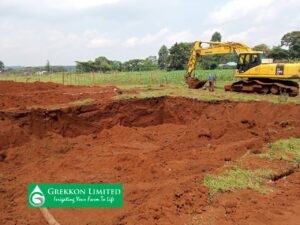
Smoothening Of The Water Pan
This is to remove any sharp objects that damage the damliner. Pour in water on the floor and sides to soften it.
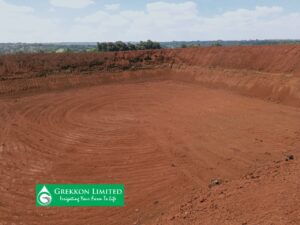
Before trench making, get a roller to compress the mould of soil that was excavated and is spread out roundabout the water pan
Trench Making
Trenches are dug round the waterpan where the damliner will be installed. The size of the trench will depend on the size of the reservoir, and the damliner thickness. The most popular trench sizes are 1ft deep by 1ft wide and 1.5ft deep by 1.5ft wide. The alternative to trenches is to use sand bags to hold the dam liner in place at the top of the water reservoir

Observe the trench made around the water pan. it is 1M from the edges of the water pan, and this is where the dam liner will be tucked
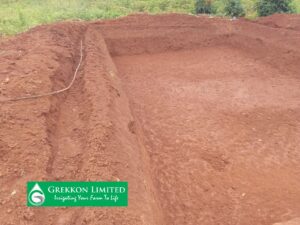
Welding structures the pond liner to the water pan’s or tank’s shape, so as to hold water. The welded joints must be leak free for the damliner to work effectively in the tank or water pan. Lined water pans are popular as water storage units for agricultural field crops irrigation in a country that has just one or two rainy seasons
Damliners In Kenya
How to join damliners together
Cut the desired damliner size from a roll. When the right size is larger than a roll, join the rolls. Welding is by either a hot blower machine for 0.5mm, or with a dam liner welding machine for larger thicknesses. The sides to be welded together are overlaid during this process to give a perfect seal. This is an important stage because any gaps that cause water seepage will mess the entire water conservation effort. A specialist must carry out this job to avoid such losses

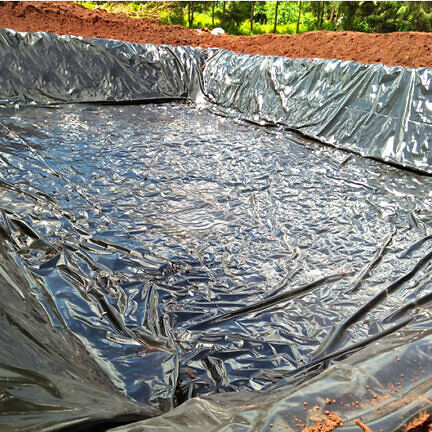
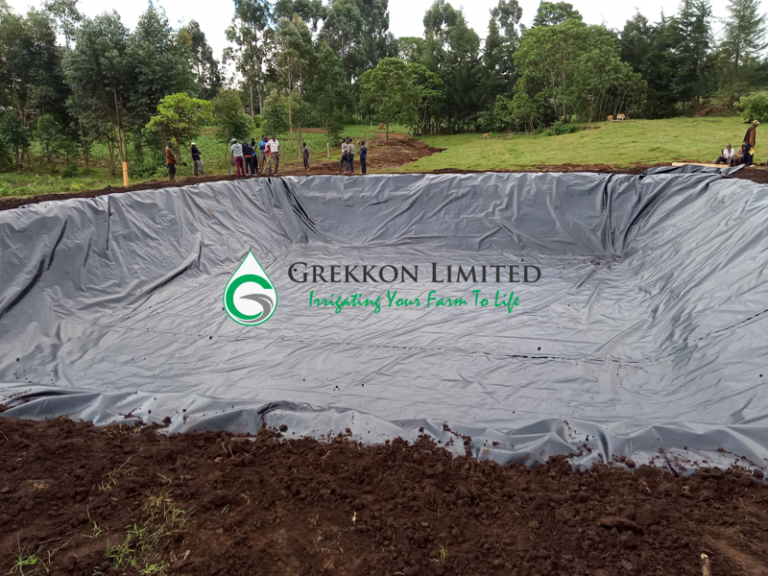
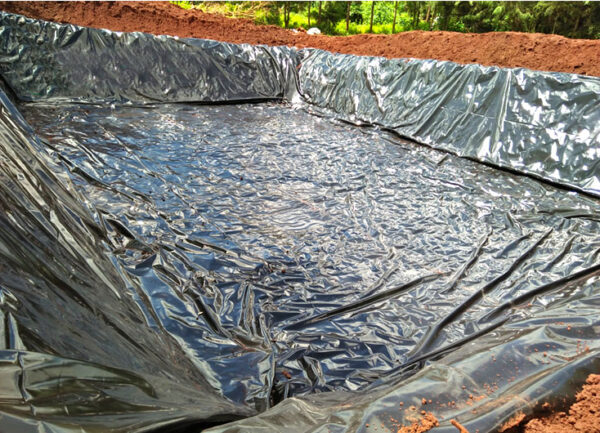
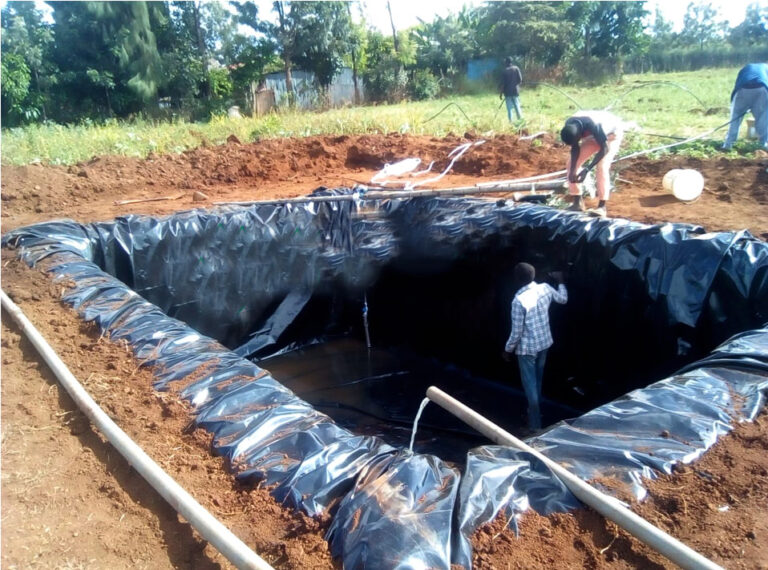
Reviews
There are no reviews yet.